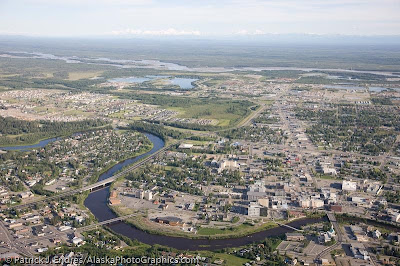 Aerial of the Chena river and downtown Fairbanks, Alaska.
Aerial of the Chena river and downtown Fairbanks, Alaska.Canon 1Ds Mark III, 24-105 f4L, 1/1000 sec @ f5.6, ISO 400
(With adjustments to the raw file to balance exposing to the right)
 (shot with exposing to the right, the RAW file looks washed out but can easily be correct to look like the file above.)
(shot with exposing to the right, the RAW file looks washed out but can easily be correct to look like the file above.)
My home town of Fairbanks is uniquely situated in the northern perimeter of the great Tanana Valley Flats. The Alaska range, many miles to the south, is visible across these flats on a clear day. Depending on a variety of factors like, dust, haze, forest fire smoke and other atmospheric phenomenon, the mountains vary in visible clarity. To get in the air spontaneously for photography when the weather is perfect is more challenging than it may appear. It requires me to be in town during a busy summer of travel, the weather needs to be very clear, and I have to find a pilot with an open schedule at the last minute. One June morning the weather was perfect, I was in town, and I was able to schedule a flight for later in the day. But, the clouds started forming as the day progressed—I decided to fly anyway. The conditions were not perfect but good enough to try.
I generally photograph with a style called "exposing to the right" and if you are interested you can read an article about this on
Luminous-Landscape. It optimizes for Signal-to-noise ratios. Since exposing to the right shifts the histogram towards the highlights, the RAW file right out of the camera looks washed out, colorless, lacks contrast and seems unusable. However, with the appropriate adjustments to brightness, contrast, etc., redistribution of the levels brings the file back to life. Here is an example of the before and the after of this particular scene. Some independent sky control was done in Photoshop, to better balance the exposure values between the land and the sky. In the next release of Adobe Lightroom 2, sky control can be applied in Lightroom to the RAW file itself. Lightroom 2 was released today.
 Alpenglow on the North and South peaks of Mt. McKinley on summer solstice
Alpenglow on the North and South peaks of Mt. McKinley on summer solstice
















